Laser-Induced Forward Transferred Optical Scattering Nanosilica for Transparent Displays
Abstract
:1. Introduction
2. Materials and Methods
3. Results and Discussion
3.1. GO-Promoted Laser Trasnfer of Nanosilica
3.2. Nanosilica-Induced Light Scattering for Transparent Displays
4. Conclusions
Supplementary Materials
Author Contributions
Funding
Institutional Review Board Statement
Informed Consent Statement
Data Availability Statement
Conflicts of Interest
References
- Hu, A. Laser Micro-Nano-Manufacturing and 3D Microprinting; Springer: Berlin/Heidelberg, Germany, 2020. [Google Scholar]
- Pfleging, W. Recent progress in laser texturing of battery materials: A review of tuning electrochemical performances, related material development, and prospects for large-scale manufacturing. Int. J. Extrem. Manuf. 2020, 3, 012002. [Google Scholar] [CrossRef]
- Mishra, S.; Yadava, V. Laser Beam MicroMachining (LBMM)—A review. Opt. Laser Eng. 2015, 73, 89–122. [Google Scholar] [CrossRef]
- Chen, T.H.; Fardel, R.; Arnold, C.B. Ultrafast z-scanning for high-efficiency laser micro-machining. Light Sci. Appl. 2018, 7, 17181. [Google Scholar] [CrossRef] [PubMed]
- Li, R.-Z.; Ji, J.; Liu, L.; Wu, Z.; Ding, D.; Yin, X.; Yu, Y.; Yan, J. A high-sensitive microwave humidity sensor based on one-step laser direct writing of dielectric silver nanoplates. Sens. Actuators B Chem. 2022, 370, 132455. [Google Scholar] [CrossRef]
- Li, R.-Z.; Wu, Z.; Ji, J.; Yin, X.; Yan, J.; Fang, Y.; Yu, Y. A Wideband Termination Based on Laser-Scribed Lossy Microstrip Line Structures. Appl. Sci. 2021, 11, 6960. [Google Scholar] [CrossRef]
- Cheng, C.; Wang, S.; Wu, J.; Yu, Y.; Li, R.; Eda, S.; Chen, J.; Feng, G.; Lawrie, B.; Hu, A. Bisphenol A Sensors on Polyimide Fabricated by Laser Direct Writing for Onsite River Water Monitoring at Attomolar Concentration. ACS Appl. Mater. Interfaces 2016, 8, 17784–17792. [Google Scholar] [CrossRef] [PubMed]
- Li, Y.; Fullager, D.B.; Angelbello, E.; Childers, D.; Boreman, G.; Hofmann, T. Broadband near-infrared antireflection coatings fabricated by three-dimensional direct laser writing. Opt. Lett. 2018, 43, 239–242. [Google Scholar] [CrossRef] [PubMed] [Green Version]
- Li, R.-Z.; Yan, J.; Fang, Y.; Fan, X.; Sheng, L.; Ding, D.; Yin, X.; Yu, Y. Laser-Scribed Lossy Microstrip Lines for Radio Frequency Applications. Appl. Sci. 2019, 9, 415. [Google Scholar] [CrossRef] [Green Version]
- Bai, S.; Serien, D.; Ma, Y.; Obata, K.; Sugioka, K. Attomolar Sensing Based on Liquid Interface-Assisted Surface-Enhanced Raman Scattering in Microfluidic Chip by Femtosecond Laser Processing. ACS Appl. Mater. Interfaces 2020, 12, 42328–42338. [Google Scholar] [CrossRef] [PubMed]
- Delaporte, P.; Alloncle, A.-P. [INVITED] Laser-induced forward transfer: A high resolution additive manufacturing technology. Opt. Laser Technol. 2016, 78, 33–41. [Google Scholar] [CrossRef]
- Li, R.-Z.; Guo, L.; Liu, L.; Yang, M.; Fang, Y.; Yu, Y.; Yan, J. Laser-Induced Forward Transfer of Silver Nanoparticles for a Black Metal Absorber. Front. Phys. 2022, 10, 520. [Google Scholar] [CrossRef]
- Zywietz, U.; Evlyukhin, A.B.; Reinhardt, C.; Chichkov, B.N. Laser printing of silicon nanoparticles with resonant optical electric and magnetic responses. Nat. Commun. 2014, 5, 3402. [Google Scholar] [CrossRef] [Green Version]
- Seyyedi, M.; Rostami, A.; Matloub, S. Comparative study of transparent display using aperiodic arrays of Si–SiO2 core–shell nanoparticles. Opt. Quant. Electron. 2020, 52, 479. [Google Scholar] [CrossRef]
- Son, I.; Lee, J.H. Highly Transparent and Wide Viewing Optical Films Using Embedded Hierarchical Double-Shell Layered Nanoparticles with Gradient Refractive Index Surface. ACS Appl. Mater. Interfaces 2020, 12, 30862–30870. [Google Scholar] [CrossRef]
- Dolatyari, M.; Jafari, A.; Rostami, A.; Klein, A. Transparent Display using a quasi-array of Si-SiO2 Core-Shell Nanoparticles. Sci. Rep. 2019, 9, 2293. [Google Scholar] [CrossRef] [PubMed] [Green Version]
- Yan, J.; Fan, X.; Liu, Y.; Yu, Y.; Fang, Y.; Li, R.-Z. Passive patterned polymer dispersed liquid crystal transparent display. Chin. Opt. Lett. 2022, 20, 013301. [Google Scholar] [CrossRef]
- Hsu, C.W.; Zhen, B.; Qiu, W.; Shapira, O.; DeLacy, B.G.; Joannopoulos, J.D.; Soljacic, M. Transparent displays enabled by resonant nanoparticle scattering. Nat. Commun. 2014, 5, 3152. [Google Scholar] [CrossRef] [Green Version]
- Monti, A.; Toscano, A.; Bilotti, F. Analysis of the scattering and absorption properties of ellipsoidal nanoparticle arrays for the design of full-color transparent screens. J. Appl. Phys. 2017, 121, 243106. [Google Scholar] [CrossRef]
- Papazoglou, S.; Zergioti, I. Laser Induced Forward Transfer (LIFT) of nano-micro patterns for sensor applications. Microelectron. Eng. 2017, 182, 25–34. [Google Scholar] [CrossRef]
- Ihlemann, J.; Weichenhain-Schriever, R. Patterned deposition of thin SiOX-films by laser induced forward transfer. Thin Solid Films 2014, 550, 521–524. [Google Scholar] [CrossRef]
- Ihlemann, J.; Weichenhain-Schriever, R. Laser-induced congruent forward transfer of SiOx -layers. Appl. Phys. A 2010, 101, 483–486. [Google Scholar] [CrossRef]
- Banks, D.P.; Kaur, K.S.; Eason, R.W. Etching and forward transfer of fused silica in solid-phase by femtosecond laser-induced solid etching (LISE). Appl. Surf. Sci. 2009, 255, 8343–8351. [Google Scholar] [CrossRef] [Green Version]
- Wang, H.; Robinson, J.T.; Li, X.; Dai, H. Solvothermal reduction of chemically exfoliated graphene sheets. J. Am. Chem. Soc. 2009, 131, 9910–9911. [Google Scholar] [CrossRef] [PubMed]
- Li, R.-Z.; Peng, R.; Kihm, K.; Bai, S.; Bridges, D.; Tumuluri, U.; Wu, Z.; Zhang, T.; Compagnini, G.; Feng, Z. High-rate in-plane micro-supercapacitors scribed onto photo paper using in situ femtolaser-reduced graphene oxide/Au nanoparticle microelectrodes. Energy Environ. Sci. 2016, 9, 1458–1467. [Google Scholar] [CrossRef]
- Zhang, Y.; Guo, L.; Wei, S.; He, Y.; Xia, H.; Chen, Q.; Sun, H.-B.; Xiao, F.-S. Direct imprinting of microcircuits on graphene oxides film by femtosecond laser reduction. Nano Today 2010, 5, 15–20. [Google Scholar] [CrossRef]
- Shown, I.; Hsu, H.C.; Chang, Y.C.; Lin, C.H.; Roy, P.K.; Ganguly, A.; Wang, C.H.; Chang, J.K.; Wu, C.I.; Chen, L.C.; et al. Highly efficient visible light photocatalytic reduction of CO2 to hydrocarbon fuels by Cu-nanoparticle decorated graphene oxide. Nano Lett. 2014, 14, 6097–6103. [Google Scholar] [CrossRef]
- Arul, R.; Oosterbeek, R.N.; Robertson, J.; Xu, G.; Jin, J.; Simpson, M.C. The mechanism of direct laser writing of graphene features into graphene oxide films involves photoreduction and thermally assisted structural rearrangement. Carbon 2016, 99, 423–431. [Google Scholar] [CrossRef]
- Zhou, Y.; Bao, Q.; Varghese, B.; Tang, L.A.; Tan, C.K.; Sow, C.H.; Loh, K.P. Microstructuring of graphene oxide nanosheets using direct laser writing. Adv. Mater. 2010, 22, 67–71. [Google Scholar] [CrossRef]
- Fardel, R.; Nagel, M.; Nuesch, F.; Lippert, T.; Wokaun, A. Laser-induced forward transfer of organic LED building blocks studied by time-resolved shadowgraphy. J. Phys. Chem. C 2010, 114, 5617–5636. [Google Scholar]
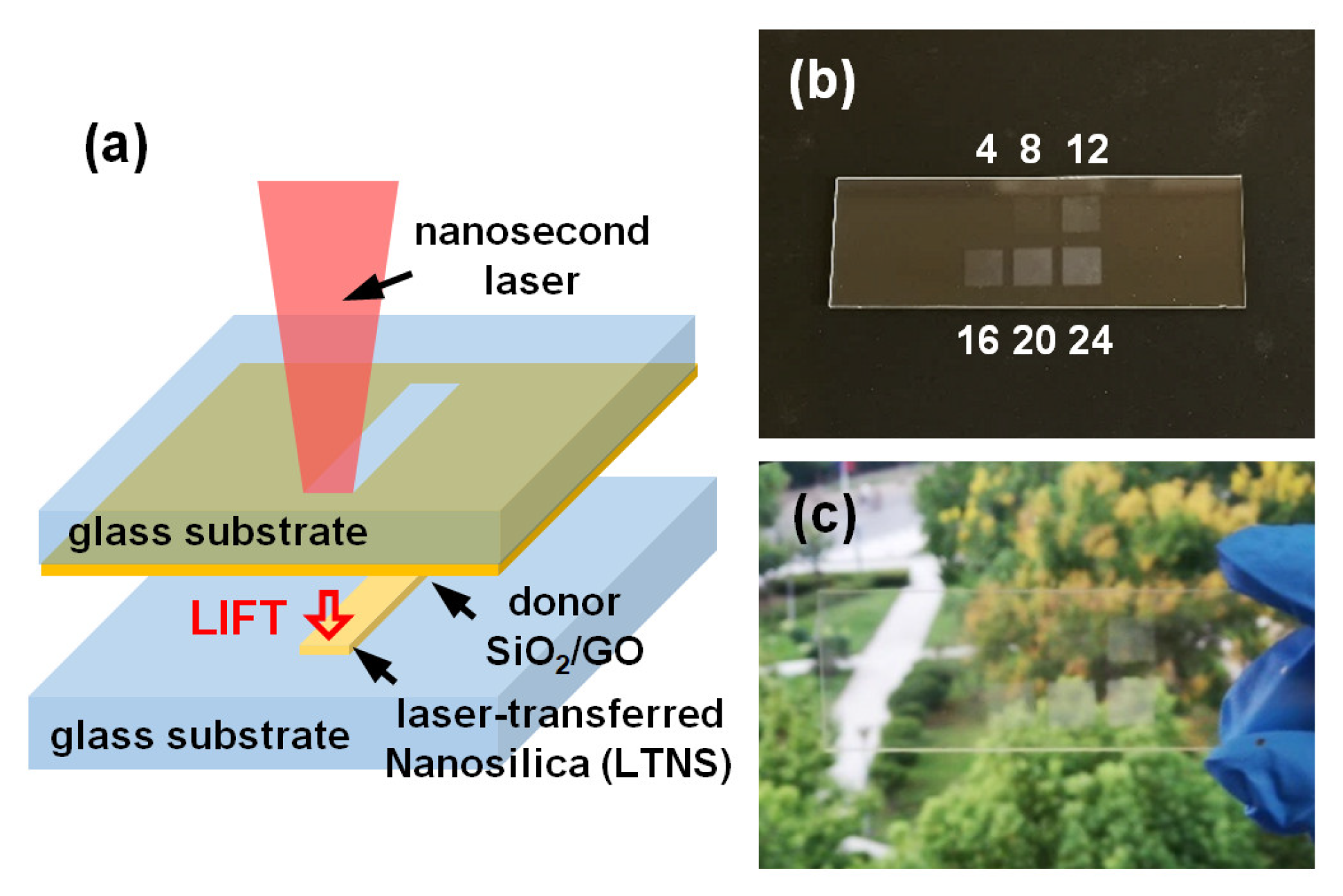
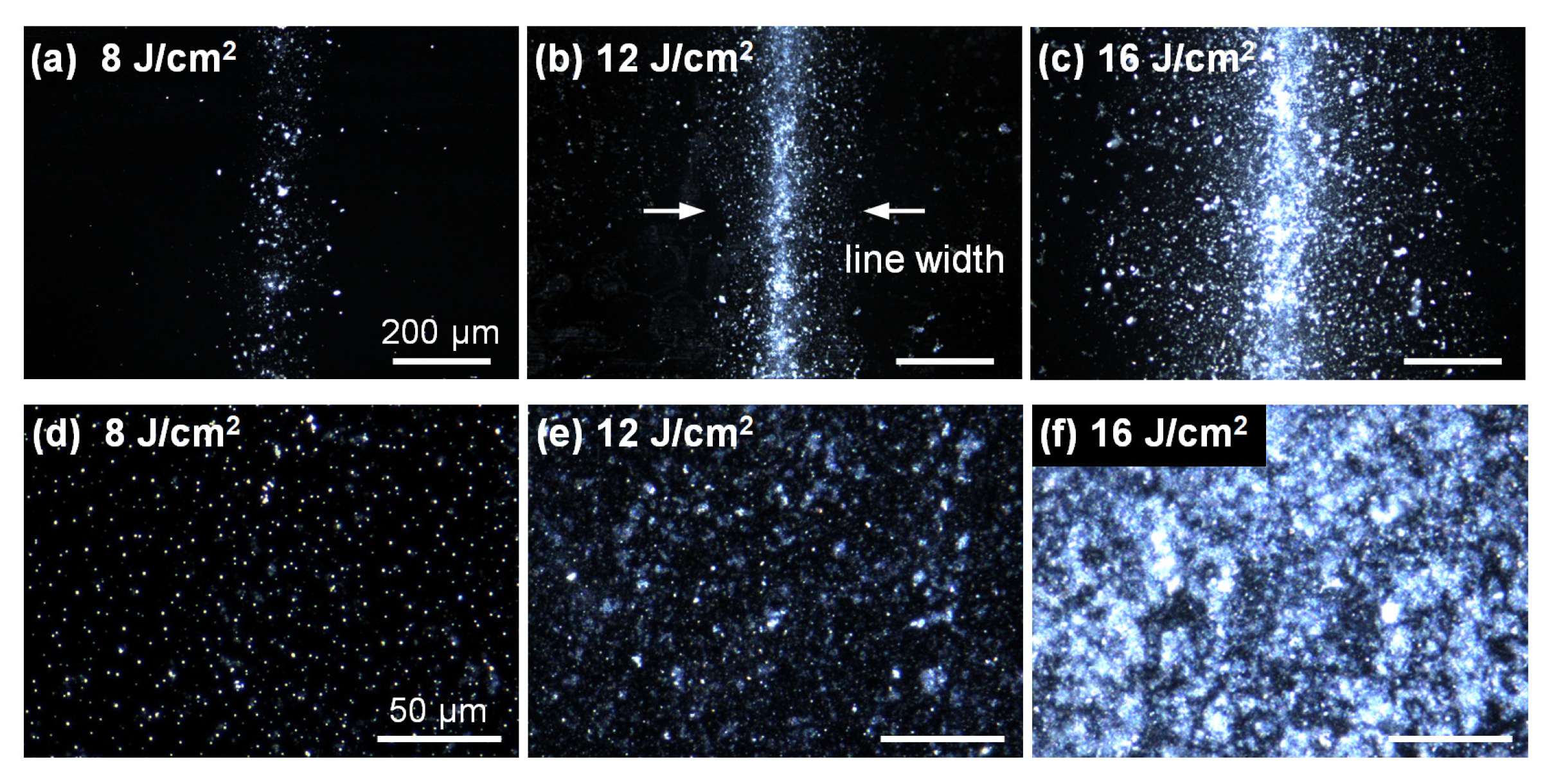
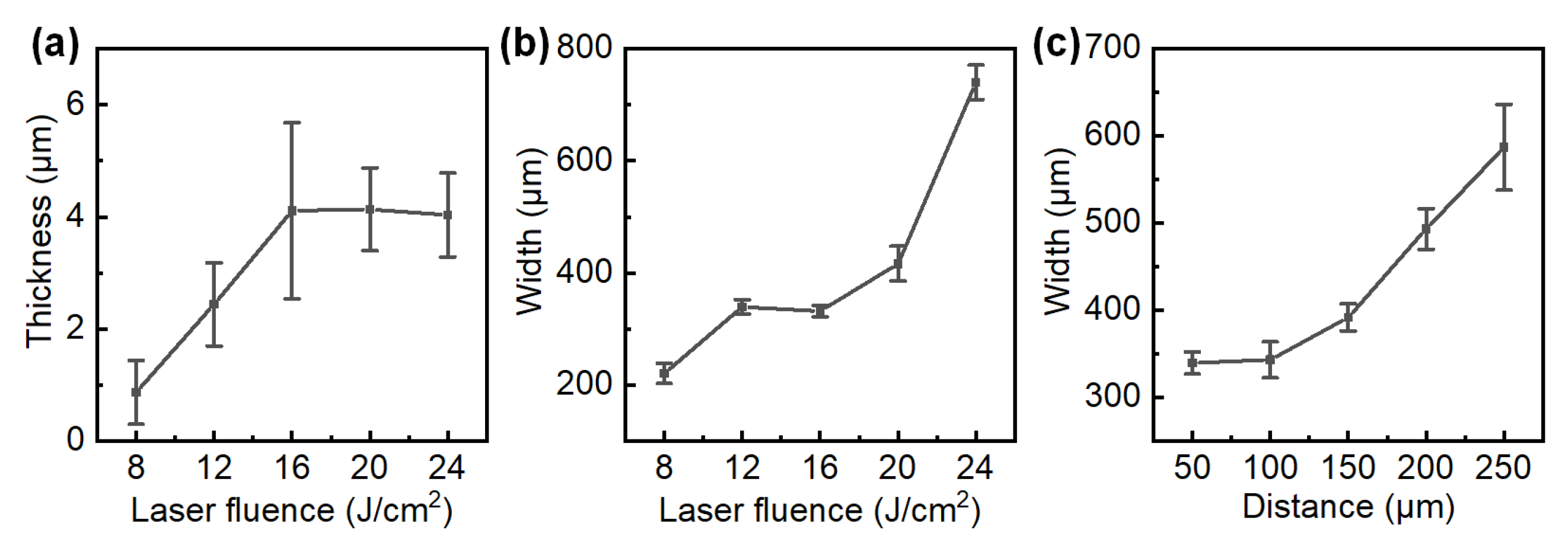

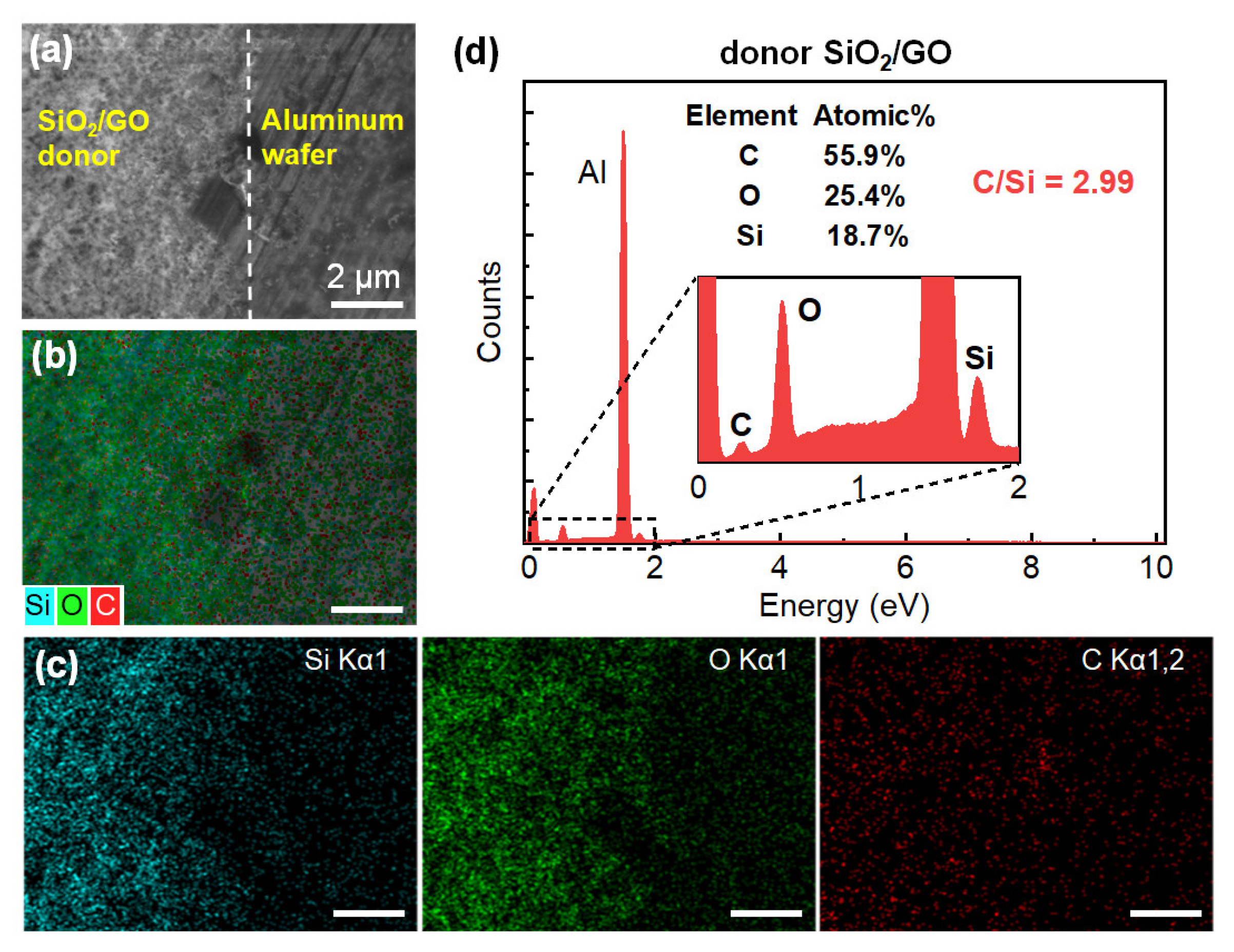
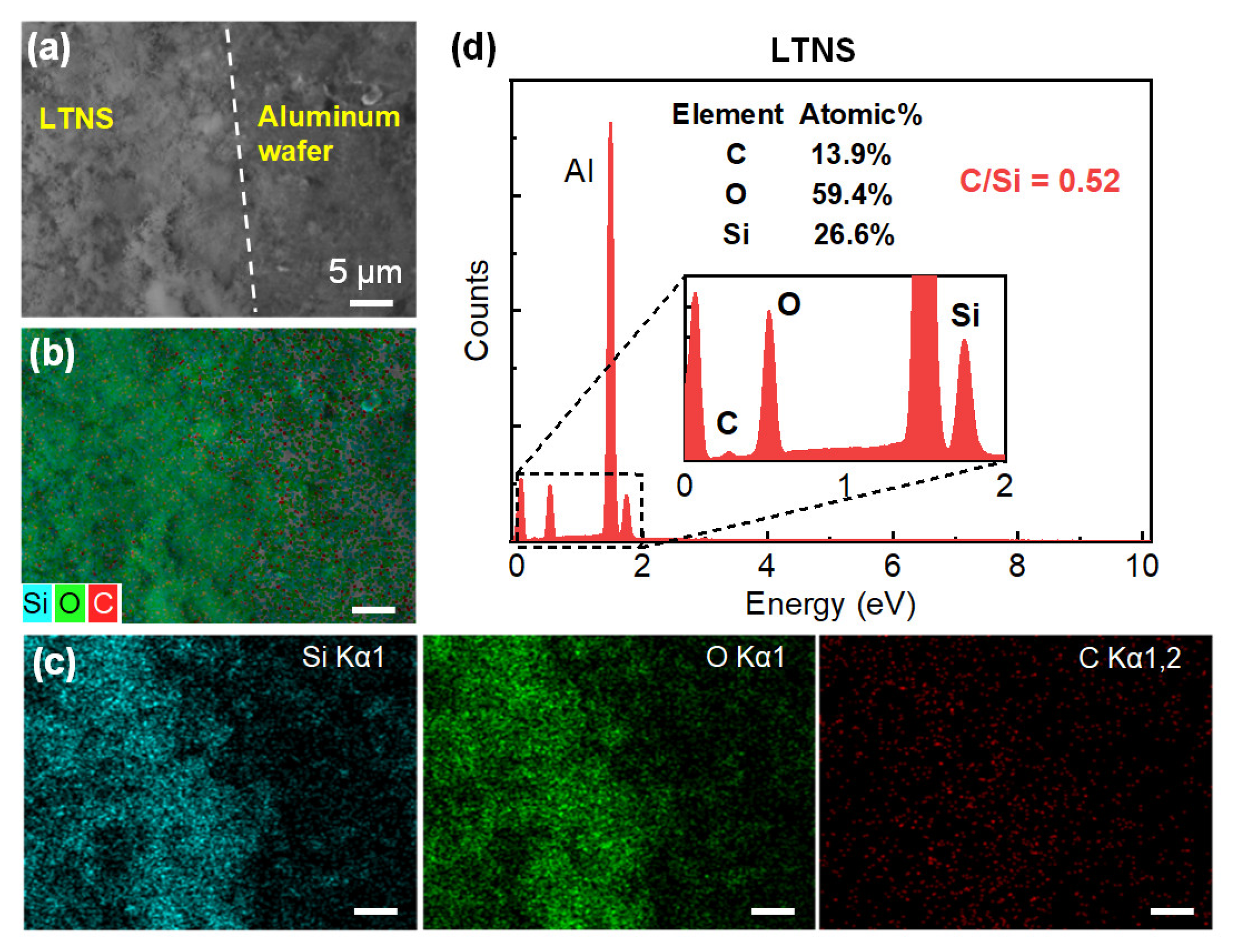

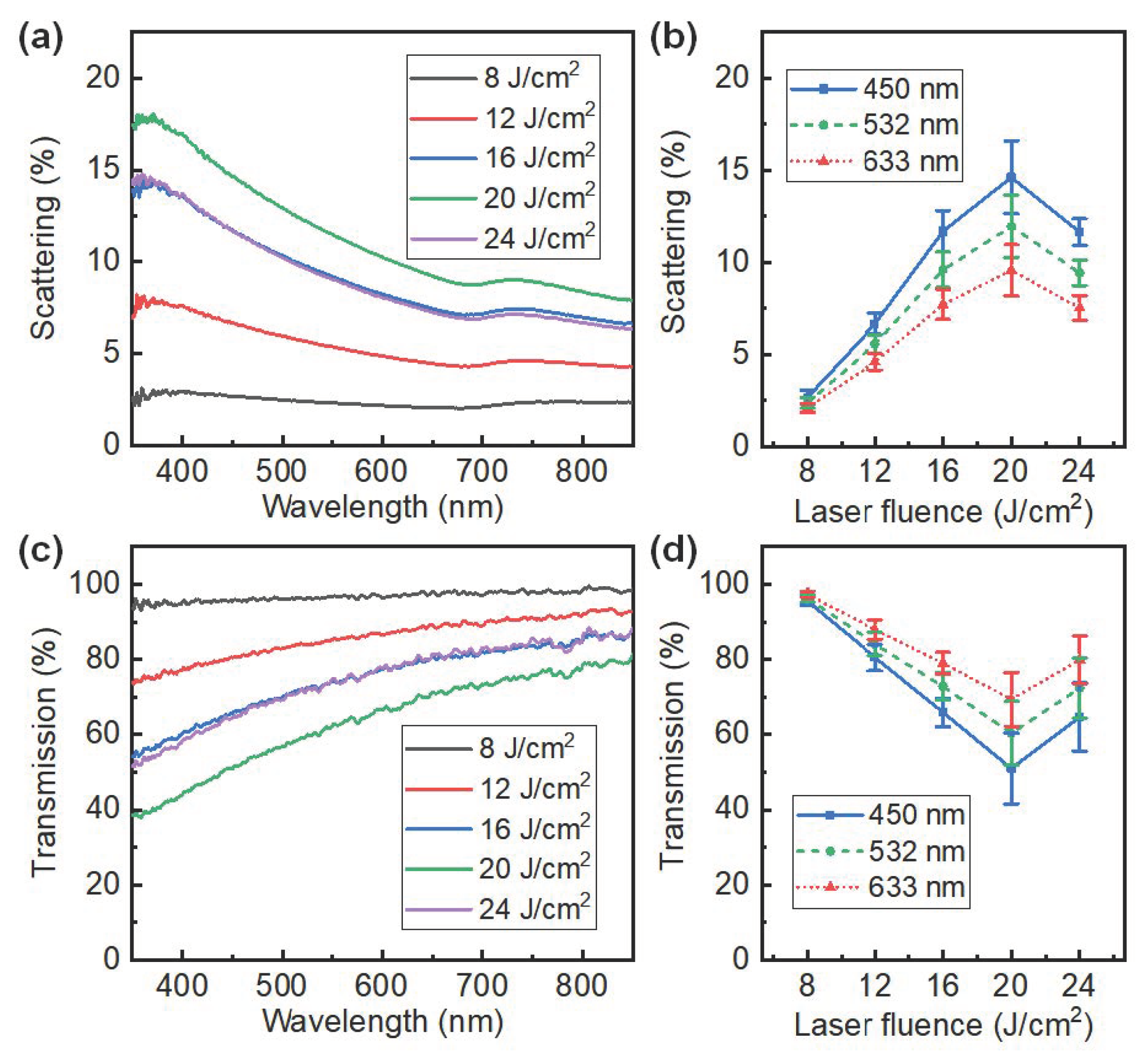
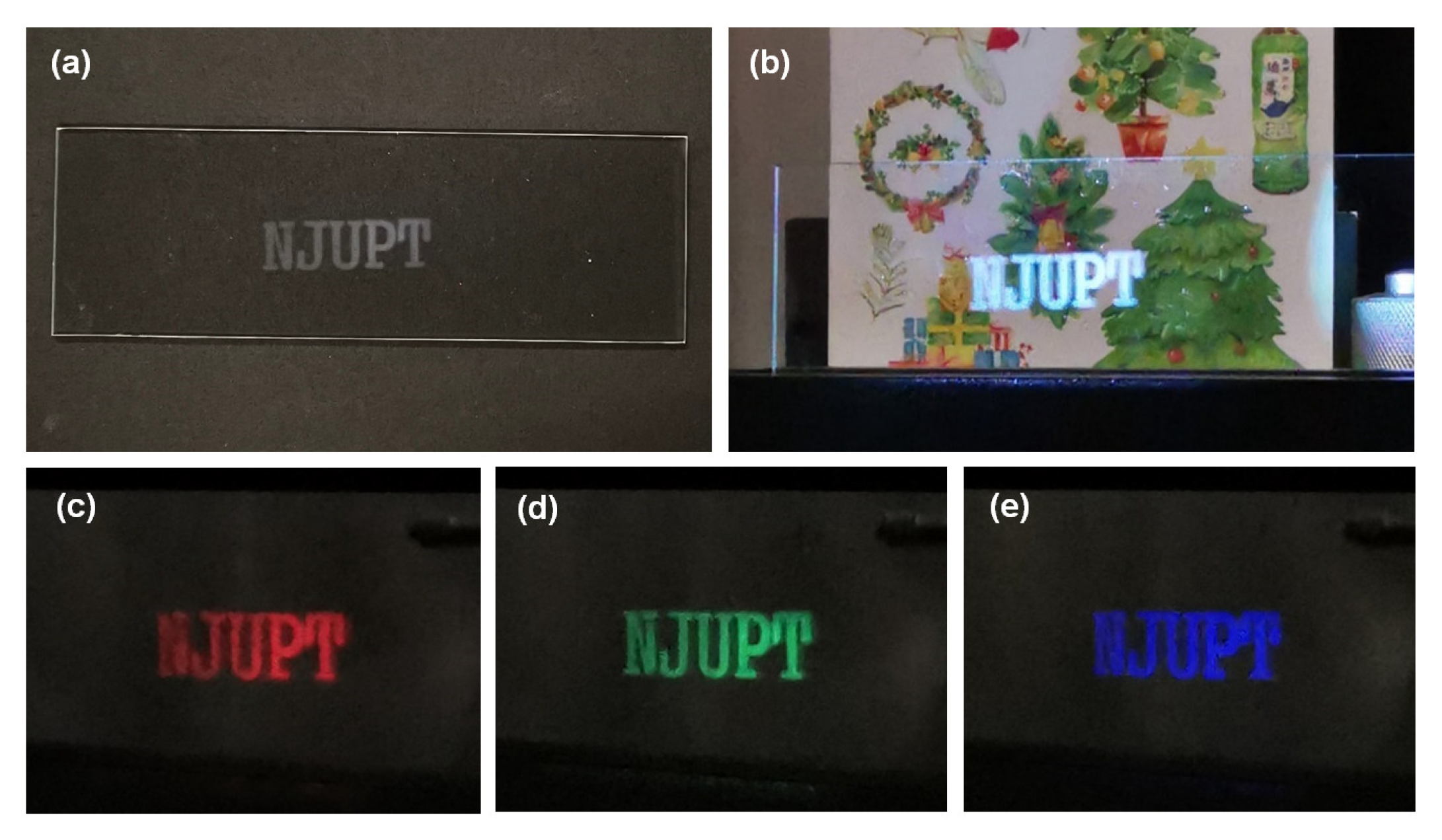

Publisher’s Note: MDPI stays neutral with regard to jurisdictional claims in published maps and institutional affiliations. |
© 2022 by the authors. Licensee MDPI, Basel, Switzerland. This article is an open access article distributed under the terms and conditions of the Creative Commons Attribution (CC BY) license (https://creativecommons.org/licenses/by/4.0/).
Share and Cite
Li, R.-Z.; Yang, M.; Guo, L.; Qu, K.; Jian, T.; Yu, Y.; Yan, J. Laser-Induced Forward Transferred Optical Scattering Nanosilica for Transparent Displays. Nanomaterials 2022, 12, 3674. https://doi.org/10.3390/nano12203674
Li R-Z, Yang M, Guo L, Qu K, Jian T, Yu Y, Yan J. Laser-Induced Forward Transferred Optical Scattering Nanosilica for Transparent Displays. Nanomaterials. 2022; 12(20):3674. https://doi.org/10.3390/nano12203674
Chicago/Turabian StyleLi, Ruo-Zhou, Mingqing Yang, Lvjiu Guo, Ke Qu, Tong Jian, Ying Yu, and Jing Yan. 2022. "Laser-Induced Forward Transferred Optical Scattering Nanosilica for Transparent Displays" Nanomaterials 12, no. 20: 3674. https://doi.org/10.3390/nano12203674




